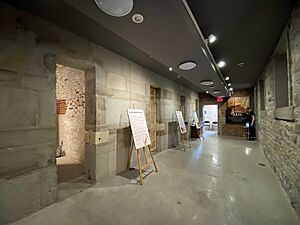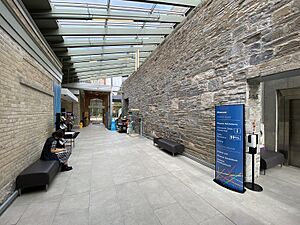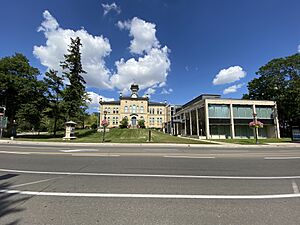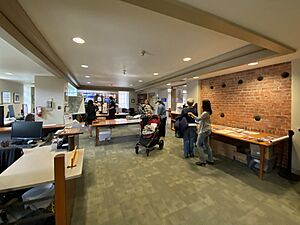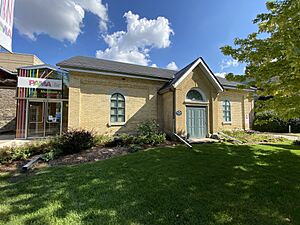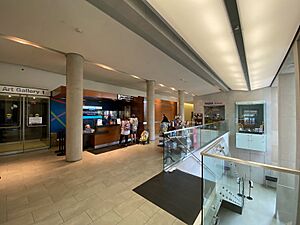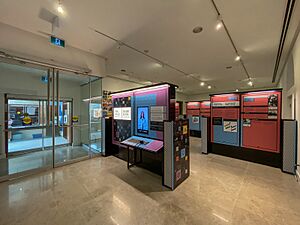Peel Art Gallery, Museum and Archives facts for kids
| Established | November 1968 |
|---|---|
| Location | Brampton, Ontario, Canada |
| Type | museum/art gallery/archives for the Peel Region |
| Public transit access | Brampton Transit (Hurontario), various GO bus routes |
The Peel Art Gallery, Museum and Archives (PAMA) is a cool place in Brampton, Ontario, Canada. It's like three places in one: an art gallery, a museum, and an archives. PAMA helps us learn about the history and art of the Regional Municipality of Peel. Before it was PAMA, it was known as the Peel Heritage Complex. The buildings used to be the Peel County Courthouse, the Brampton Jail (also called the Peel County Gaol), an office for land records, and a county administration building. You can find PAMA right across from Gage Park and Brampton City Hall.
In March 2010, the Peel Heritage Complex closed for a big makeover and expansion. It reopened in 2012 with much larger spaces for everyone to enjoy. When it reopened, it got a new name: Peel Art Gallery, Museum and Archives.
Contents
PAMA's Story
People first tried to create a historical society in the early 1900s, but it didn't work out. For many years, a collection of art and old items from William Perkins Bull was kept at the Brampton High School. In the 1950s, the school needed to renovate, so the collection had to be moved. Some citizens, including C. V. Charters and Everett Briggs, decided to create a new historical society. They wanted to focus on life in Peel County from the late 1700s to the 1930s. However, the group became inactive in 1957.
In February 1961, interested people met again to restart the society. They met in the basement of the Carnegie Library. The County Council of Peel allowed the group to use the basement of the old Registry Office for their meetings. Regular meetings started in 1962.
With help from local Women's Institutes, an art show was held in an old school house. This show helped raise money to create a museum and art gallery. It featured art by local artists and items from the Bull Collection. In 1963, a temporary home for the collection was found at the Credit Valley Conservation Authority offices. Many people visited the exhibits.
Later in 1963, the organization became part of the Ontario Historical Society again. They displayed items at a big farming event called the International Ploughing Match. The society also tried to get access to Hawthorne Lodge, which was the original home of the Bull family.
In 1966, the Peel County Council decided that the old Registry Office building should be used for the society to set up a museum.
The museum officially opened on November 17, 1968. It had professionally designed exhibits that were different from other county museums. The displays showed the rural past and the technical present of the area. The first art gallery exhibit featured a Brampton watercolour artist and a sculptor.
In 1984, the Region of Peel took over PAMA. An architect named Carlos Ventin was hired to design renovations for the Peel County Jail and the Peel County Registry Office. He also designed a building to connect them.
The architecture won awards in 1986 and 1987 for its design and renovation work.
A curator named Bill Barber wanted to show historical topics like the Great Depression in the museum. This was different from the usual pioneer-era exhibits. The museum also created shows about different festivals around the world.
More and more people started visiting PAMA. Attendance grew from 6,000 visitors in 1985 to 24,000 in 1989.
PAMA's Buildings
The company Goldsmith Borgal and Company Ltd. Architects designed PAMA's big renovations that happened from 2010 to 2012.
The Tunnel
The different buildings at PAMA are connected by a long tunnel. It's about 82 meters long and has two skylights that let in natural light. You enter the tunnel from the art gallery building (built in 1958). The tunnel goes partly under the old Peel County Courthouse (built in 1867). Then, it leads into a connecting building (built in 1986) that joins the 1867 Peel County Jail and the Registry Office from the 1890s. Building this tunnel was a big project that needed careful planning.
What You Can Explore at PAMA
The Museum
The museum at PAMA has about 12,000 historical items. These items show the history of Peel from about 4000 BCE (a very long time ago!) up to the 21st century. Some cool things in the collection include parts related to the Avro Canada CF-105 Arrow aircraft. There's also a collection of over 360 pieces of 19th-century stoneware (old pottery). Plus, they have a large collection of textiles, including quilts made locally and over 18,000 pieces of clothing.
The museum has many exhibitions that show the history and culture of the Peel community. In the Region of Peel Museum, you can travel through time. You'll see everything from early Aboriginal settlements to the Jet Age. All of this is inside the historic Jail building! Old items, documents, and hands-on activities tell "The Peel Story." The museum has more space for exhibitions now.
There used to be a room called the "Brain Cell" for hands-on learning. This room has been renamed in the new museum.
The Archives
The Peel Archives keeps important documents from the Region of Peel. This includes records from the City of Brampton, City of Mississauga, and Town of Caledon. It also has records from older townships like Albion and Chinguacousy. These records include things like laws, meeting notes, and land information.
Besides government documents, the archives also collects other materials about Peel's history. This includes photos from newspaper photographers like Russell K. Cooper. They also have old glass negatives from different families and studios.
The archives also holds records from various groups, like the Bruce Trail Conservancy.
In the reading room, you can look at microfilm copies of family history files from the William Perkins Bull collection. You can also find old newspapers, land records, and census records from 1851 to 1911. There are also books about local history and family trees.
The Art Gallery
PAMA's permanent art collection has over 4,000 artworks. These include both modern and historical pieces. It's the largest public art collection in the Peel region. Since it opened in 1968, the art gallery has shown works by local, national, and international artists.
Art Collection Highlights
The gallery's collection first focused on artists who lived in Peel or art that showed local subjects. Early exhibits featured artists like George Chauvignaud, who painted in Peel in the 1920s and 1930s.
In recent years, the collection has grown to include many works from the 20th century. It features art from important Canadian art movements like Les Automatistes and Painters Eleven. You can also see works by modern artists like David Urban and Ric Evans. Other famous artists in the collection include Harold Town, Jack Bush, and Doris McCarthy. Some artists like William Ronald, John Meredith, and Ronald Bloore used to live in Brampton.
The collection also has important works by national artists that are considered Canadian Cultural Property. This means they are very special and important to Canada's heritage.
A sketchbook by the famous artist Tom Thomson is also part of the collection.
Exhibitions
PAMA often has new and exciting art shows. Some past exhibitions include:
- Painted In Peel: The Peel Landscape by the Group of Seven and Their Contemporaries. This show featured art from PAMA's own collection and other major galleries.
- Wyn Geleynse: The Peel Projection. This was a special outdoor light projection art piece.
In the 1970s, the gallery started a juried art show. Artists from all over Ontario could enter their work. The gallery also has the Peel Artists Series, which features artists from the local area.
Learning and Community Programs
PAMA offers special programs for schools. These programs can happen at the museum and gallery, or even at the schools themselves. There are also programs for seniors that visit old-age facilities. These programs cover history and art topics, not just about Peel. In 2009, almost 11,000 students and nearly 6,000 seniors took part in these programs.
More About PAMA
Collections
PAMA collects many different kinds of objects. This includes items from the 1800s and early 1900s, like everyday tools and even wedding dresses. They also have archaeological items, historical and modern artworks (paintings, drawings, sculptures), and old documents like photos, government records, and maps. Volunteers help the staff organize and list all these items.
Most of the items in the collections were given by people who live in Peel. These collections are used for exhibitions, programs, and research by staff, volunteers, and visitors. A group of experts reviews every potential donation to PAMA.
Exhibitions
The Art Gallery of Peel usually features about eight exhibitions each year. These shows highlight artists from the Peel region, Ontario, and even across Canada. Every spring, the gallery holds its Annual Juried Show. This is the longest-running judged art show in the area, attracting artists from Peel and Southern Ontario.
Education
When you visit PAMA, you'll find interactive displays and hands-on activities throughout the building. These are great ways to learn!
PAMA also hosts many special events throughout the year. These events are a wonderful chance for the community to learn more about PAMA and Peel's history. You can explore the old items, documents, and artwork in PAMA's collections. Some popular events include Heritage Day in February, Museum Day in May, Kidsummer in July, and Family Day in November.
Affiliations
PAMA is connected with several important organizations. These include the CMA, the CHIN, and the Virtual Museum of Canada.


